Matteo Salvini, the leader of Italy’s popular far-right party the League, was ousted from power last week amid the formation of a new coalition government between the Five Star Movement and the center-left Democratic Party (PD), replacing the Five Star-League alliance. News headlines describe Salvini as a victim of his own ego, saying he has scored an own goal.
Yet, the League’s leader is out but not down. Being in the opposition exempts Salvini from having to vote for an unpopular budget law (due in December 2019) in which he could not implement the flat tax measure he had long advocated because of the budget restrictions and deficit/GDP ratio agreed with the European Union. And the PD’s internal dynamics — pitting a faction led by former Prime Minister Matteo Renzi against one led by PD leader Nicola Zingaretti — risk splitting the party and therefore the coalition government before the current legislative session ends in 2023. Depending on how soon this happens, the League could capitalize on its current popularity and attack the Five Star Movement and the PD for the unpopular budget law, a weak economy, and an “undemocratic” takeover of power.
Whenever they are called to the polls, Italians will have to evaluate the achievements of the Five Star Movement-PD alliance, in which both compromised on their own political stances (including an existential disapproval of one another) to kick Salvini out of power. This alliance risks overshadowing the independent identities of each party and intensifying Italians’ sense that they lack representation — a sense that Salvini would easily exploit.
Since the March 2018 elections, Salvini’s charisma, nationalist message, and cunning communication strategy allowed the League to devour the electoral support of the Five Star Movement and Silvio Berlusconi’s Forza Italia. Salvini has established the League as the unquestioned leader of the Italian right. When the Italian electorate swings back to the right, it will find a cohesive front, united behind the leadership of a Prime Minister Salvini.
HOW SALVINI ATE THE CENTER RIGHT
Salvini was born in Milan in 1973 to a business manager and a housekeeper. He never finished his studies in political science and history, yet he made his way up to the leadership of the Northern League party — rebranded simply the League in 2018 — through his long-term commitment to its cause of an independent “Padania” (literally indicating the regions based in the Po Valley, from Friuli to Piemonte). He first joined the Movement of Padanian Communists and worked as journalist for the La Padania newspaper. At age 20, he was elected to the Milan city council. Salvini was elected as Northern League deputy to the European Parliament in 2004, 2009, and 2014, and to the Italian Chamber of Deputies in 2008 and 2013. (On both occasions, he quit the parliament in Rome in favor of the one in Brussels.)
Five years ago, the Northern League was in complete disarray following the scandal of illegal electoral reimbursements involving the family of its original founder, Umberto Bossi. Yet, since Salvini took over the leadership of the party in late 2013, the party’s political trajectory has reached a crescendo: from 4% in the 2013 Italian elections to 6% in the 2014 European elections to 17% in the 2018 Italian elections to 34% in the May 2019 European elections, which made the League the largest party from Italy and the third-largest party overall in the European Parliament.
Salvini’s strategy revolved around a cunning attempt to establish the League as the main political force from the right and therefore expand its electoral base beyond Italy’s northern regions.
In setting up a coalition with Forza Italia and two other minor formations for the 2018 electoral campaign, Salvini profited from his allies’ lack of top-tier leadership: Berlusconi was still banned from standing for office due to his conviction for tax fraud in his media empire (he has now moved to Brussels as a member of the European Parliament). Salvini gradually charmed the center-right’s electorate with the promise of fiscal reforms and tax amnesties, traditional right-wing stances. Removing “Northern” from the League’s brand was a further attempt to expand its base and connect with central and southern Italian voters. While keeping the focus on the promise of accomplishing more fiscal autonomy for the northern regions of Italy (to consolidate its original electoral base), the party also changed the color of its symbol from green (historically the color of Padania) to dark blue, the color normally used by the center right.
However, more than these cosmetic changes, what contributed the most to formalizing the League’s posture as a national party was timing. Extending its sovereigntist messages to the country as a whole rather than just the wealthier regions of the north, the League rode the wave of dissatisfaction with developments like the euro crisis and the refugee crisis, in the context of a broader European and global rise of illiberal, sovereigntist political forces. With an anti-elite, anti-immigration, and anti-Europe narrative that focused on the national interest, the League began to conquer the Italian electorate.
In the March 2018 election, the right-wing coalition received the most votes, as expected. The League outperformed its polling to eclipse Forza Italia as the largest party on the right (with 17.4% of the vote). With the parliament fractured by the rise of the Five Star Movement (with 32.7%), the League formed a coalition with its fellow populists, and Salvini became interior minister. His party quickly began to punch above its weight in government and cannibalize other parties’ support.
HOW SALVINI’S ‘BEAST’ CONQUERED THE ITALIAN ELECTORATE
Over the past year and a half, Salvini’s communications team made him the Italian politician with the most “likes” on Facebook, with 4 million followers. (For comparison: The leader of the Five Star Movement, Luigi Di Maio, has 2.2 million followers; former prime ministers Matteo Renzi and Silvio Berlusconi have 1 million each.) Led by digital strategist Luca Morisi, the team works 24/7 through the help of “The Beast,” an internet tool used to sense the sentiment of web users. They produce targeted content based on the analysis of the interactions with Salvini’s social media posts and the data on users themselves.
Through a series of simple and repetitive messages, Morisi essentially created a cult of personality around Salvini, pairing concepts like “sovereignty belongs to the people” and “Italians first” with an effective selection of news content. The emphasis on stories about criminal actions by illegal immigrants and NGO ships “violating Italian sovereignty” while rescuing migrants are designed to increase Italians’ threat perception and enhance anti-immigrant sentiment, as well as question the country’s international obligations. Salvini’s activities on social media target different social groups and promote the image of a leader that is traditional, down-to-earth, and accessible: from kissing the rosary and invoking the Virgin Mary, to eating food from well-known Italian brands; from wearing military-branded gear to taking pictures in bathing suit that recall iconic photos of Vladimir Putin or Benito Mussolini.
These messages are designed to provoke reactions not just by Salvini’s supporters, but also by his critics, who end up commenting and sharing his content, contributing to his online visibility. The casual reference to fascist narrative and symbols — such as talking about strengthening ties between Italy and Germany using the expression “a new Rome-Berlin axis,” addressing the crowd from the same balcony in Forlì where Mussolini delivered famous speeches, and advocating for “plenary powers” (like Hitler in 1933) — is one way Salvini dominates social media and news coverage.
HELP FROM CONTROVERSIAL CONNECTIONS: CASAPOUND, RUSSIA, AND THE AMERICAN ALT-RIGHT
In building his power base as a nationalist leader, Salvini took advantage of connections with obscure far-right and nationalist networks both domestic and international.
In his early days at the head of the Northern League, Salvini cultivated ties with CasaPound, a group of political militants known for its neofascist positions and violent actions. In 2015, the leader of CasaPound, Simone Di Stefano, gave a speech onstage during a League-organized rally in Rome to protest against the Renzi government. Salvini never distanced himself from reported criminal acts involving CasaPound members, and in 2019, Altafonte Publishing House—directed by a prominent CasaPound member—published a book-length interview of Salvini.
Salvini’s far-right connections extend beyond Italian soil. Very recently, BuzzFeed News reported that Salvini’s party allegedly received illegal Russian funding, raising awareness on the proximity between the League and Russian far-right circles. While Salvini has publicly expressed his admiration for Putin multiple times, one of his closest collaborators, Gianluca Savoini (currently under investigation for the Russian funding affair) was working behind the scenes to organize Salvini’s trips to Moscow and keep personal and business contacts with far-right circles in Russia. Savoini’s Lombardy-Russia Association — created in 2014 to “fight disinformation on the Ukraine crisis” — regularly invites Russian intellectuals who would support Russia’s geopolitical claims and promote its conservative social values, including Aleksander Dugin and Alexey Komov. Whether or not Russia funded the League’s campaign for European elections, the longstanding ties between the League and Russian far-right circles would make them stronger allies in a scenario in which Salvini has a freer hand to make Italian foreign policy.
Salvini’s political trajectory gained the admiration of Steve Bannon, who was chief executive of Donald Trump’s campaign and then chief strategist in the White House for a year in 2016-17. In 2018, Salvini joined Bannon’s The Movement, a think tank of sorts, conceived as a coordination platform for international sovereigntist politicians and thinkers. According to the journalist Jacopo Iacoboni, who investigated the Five Star Movement and League connections with international sovereigntist movements, Bannon has also played a role in facilitating the formation of the Five Star Movement-League government, which he viewed as an incredible experiment. To this day, Bannon and his circle praise Salvini for his similarities to Trump.
WHAT A SALVINI RETURN WOULD LOOK LIKE
Salvini is already agitating the masses, urging Italians to keep their phones on because “if we need to take the squares to save Italy, freedom, and democracy, we will be there.” He claimed that the Five Star Movement and the PD had been conspiring against him for a long time, and is depicting their formation of a new coalition government as an attack to democracy.
If the League were to perform well in a future election and Salvini were to return to government as prime minister, sovereigntism would dominate Italian foreign policy even more than it has in the past 14 months. His immigration policies, ideas of economic protectionism, and Eurosceptic, anti-Iran, and anti-China positions brought Salvini much closer to the Trump administration than to Italy’s European partners. In this scenario, it is not hard to imagine that Salvini’s sovereigntist stances and preference for bilateral over multilateral relations would lead Italy to shed the diplomatic posture that traditionally embeds it in the West while keeping the door open to engage other actors such as Russia and North African countries. Salvini’s confrontational approach towards the EU would move Italy out of the core of EU decision-making and reduce Rome’s influence in international arena. While Salvini prefers to engage directly with great powers, specifically the United States and Russia, the reduced political leverage would expose Italy to greater pressure to agree to their demands based on power politics. For the sake of protecting Italy’s sovereignty, Salvini’s leadership would do quite the opposite.
In the meantime, as leader of the opposition, Salvini will have time to work on his international connections with parties and far-right movements, as well as build up and lead a cohesive sovereigntist front able to compromise the EU integration project. He never stopped campaigning, even after he became minister of interior — he will hardly stop now. Salvini will not only exploit every possible opportunity to remark on the new government’s distance from the “real Italy,” but also capitalize on the inevitable struggles between the Five Star Movement and the PD as they compromise their political profiles. The “beast” of the Italian right is not going away.
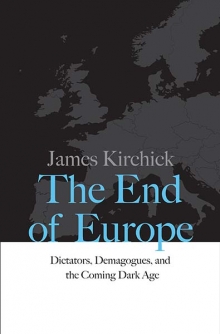
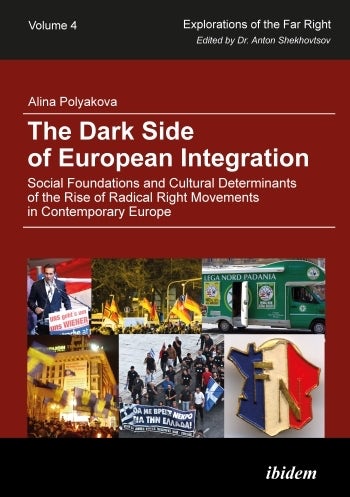
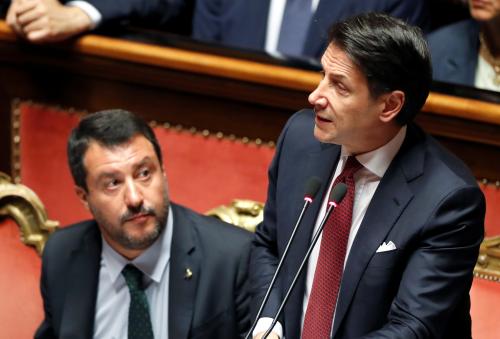
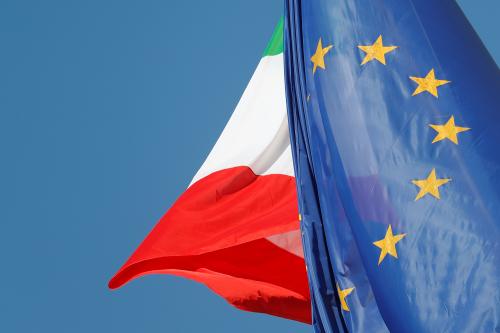

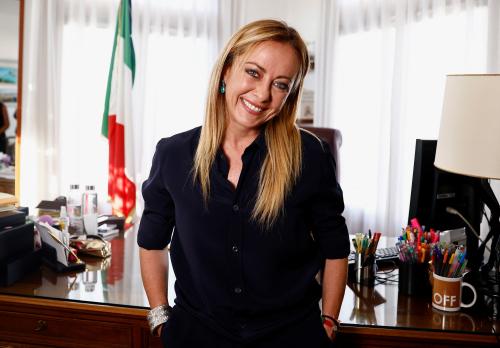
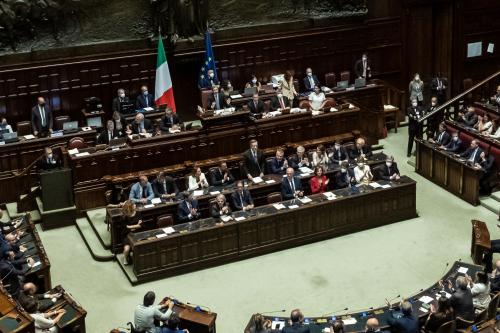
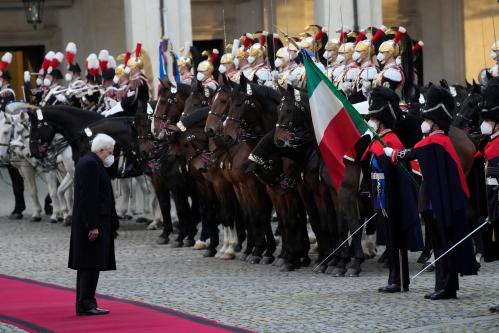
Commentary
Matteo Salvini is out but not down
September 4, 2019